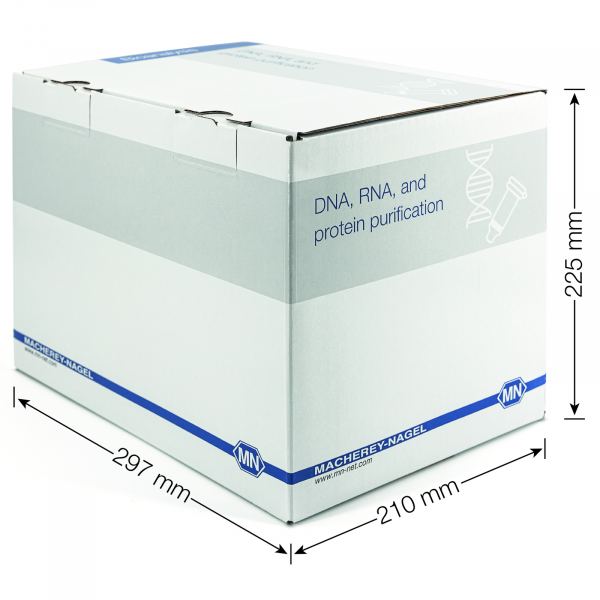NucleoSpin DNA FFPE XS, Micro kit for DNA from FFPE
*taxes and shipping not included
XS spin kit for isolation of DNA from formalin-fixed paraffin-embedded samples
| Application | Isolation of DNA |
| Selling unit | 10 Prep(s), 50 Prep(s), 250 Prep(s) |
| Target | DNA |
| CE certified | No, research use only |
| Technology | Silica membrane technology |
| Brand | NucleoSpin |
| Format | Mini prep |
| Handling | Centrifugation |
| Lysate clarification | Centrifugation |
| Automated use | No |
| Sample material | FFPE, Fixed samples, Tissue sections |
| Sample amount | ≤ 7 sections (10 µm) of 250 mm² total area, < 15 mg paraffin |
| Fragment size | 50 bp–approx. 50 kbp |
| Typical yield | Depending on amount and quality of sample |
| Theoretical binding capacity | 50 µg |
| Elution volume | 5–30 µL |
| Preparation time | 70 min/6 preps (excl. lysis) |
| Typical downstream application | PCR |
| Storage temperature | 15–25 °C / 59–77 °F |
| Shelf life (from production) | 24 Month(s) |
| Hazardous material | Yes |
NucleoSpin DNA FFPE XS
- Very easy paraffin removal – Paraffin Dissolver (patented technology) included
- Concentrated DNA by elution in small volume
- Overcoming formalin crosslinking of DNA by incubation in decrosslinking buffer
- High quality DNA for improved performance in PCR
NucleoSpin DNA FFPE XS procedure
Isolation of DNA from formalin-fixed, paraffin-embedded samples made easy
The NucleoSpin DNA FFPE XS kit provides a convenient, reliable, and fast method to isolate DNA from formalin-fixed, paraffin-embedded (FFPE) tissue specimen. The procedure omits the use of flammable and malodorous xylene or d-limonene commonly used for deparaffinization. Further, the procedure omits the difficult removal of organic solvent from often barely visible tissue pellets. NucleoSpin DNA FFPE XS employs the odorless Paraffin Dissolver (patent pending) and allows efficient lysis in a convenient two-phase system**.
First, the paraffin of FFPE sections is dissolved in the Paraffin Dissolver. Tissue is then digested by proteinase to solubilize the fixed tissue and release DNA into solution. Subsequently, heat incubation with a specially designed buffer effectively eliminates crosslinks from the previously released DNA. After addition of ethanol, the lysate is applied to the NucleoSpin DNA FFPE XS Column. DNA is bound to the silica membrane. Two washing steps help to remove salts, metabolites, and macromolecular cellular components. Pure DNA is finally eluted under low ionic strength conditions in a small volume (5–30 μL) of Elution Buffer BE, yielding highly concentrated DNA.
Isolated DNA is high in concentration, formaldehyde crosslinks are reversed efficiently, and the DNA quality of the sample is well preserved during the complete process (deparaffinization, decrosslink, purification). Thus, isolated DNA shows good performance in typical downstream applications like PCR.
Outstanding PCR performance due to efficient recovery of well decrosslinked DNA

DNA was isolated from formalin-fixed and paraffin-embedded rat liver tissue with NucleoSpin DNA FFPE XS (2x, blue graphs) and with a FFPE mini elution kit from competitor Q (2x, orange graphs).
DNA isolated with NucleoSpin DNA FFPE XS is consistently high in yields and shows better performance in the PCR reaction than the competitor kit.
Roche LightCycler real-time PCR, target length: 100 bp.
Starting material each: 1 section FFPE rat liver; overnight lysis; 30 μL elution volume.

Elution volume depends on membrane diameter!

MACHEREY-NAGEL (MN):
The Xtra Small diameter of the NucleoSpin DNA FFPE XS membrane allows efficient elution in only 5–20 μL.
Competitor Q (Q):
Even the kit especially designed for very small samples amounts does not have optimized column features for the desired application, thus elution requires at least 20–30 μL.

** Users preferring xylene deparaffinization will find protocols utilizing xylene for deparaffinization in the manual. Deparaffinization using xylene shows the same efficiency as deparaffinization using Paraffin Dissolver. Xylene is not included in the kit.













